Germany Last Mile Delivery Market Size
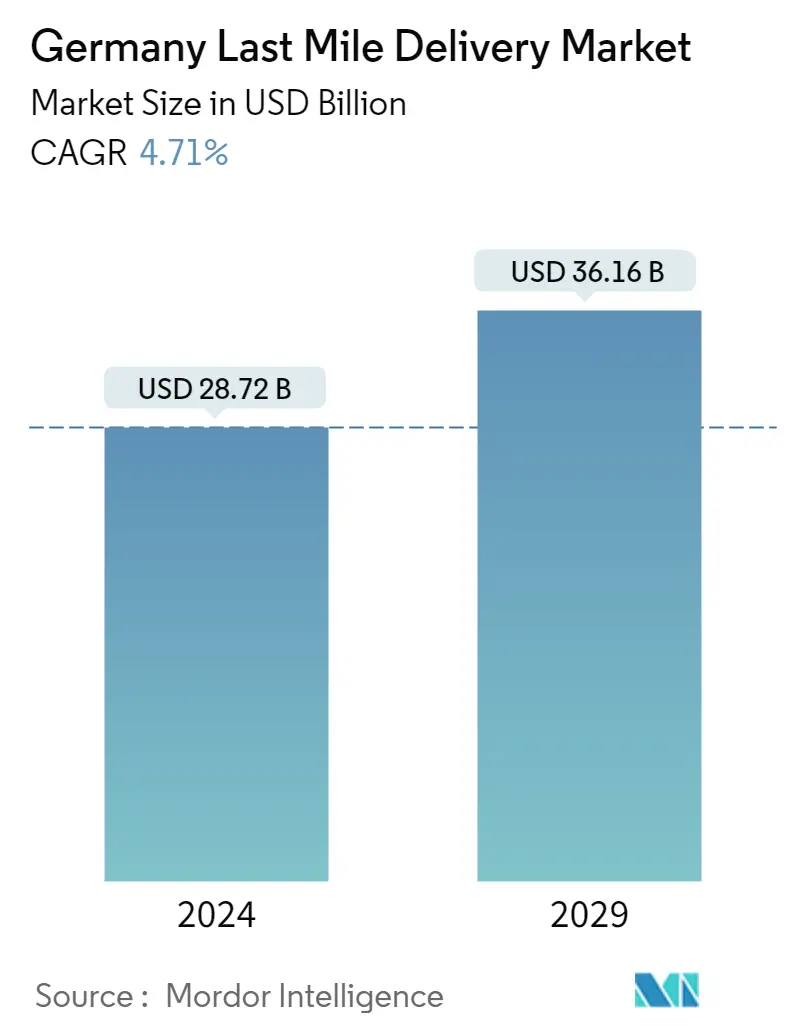
| Study Period | 2020 - 2029 |
| Base Year For Estimation | 2023 |
| Market Size (2024) | USD 28.72 Billion |
| Market Size (2029) | USD 36.16 Billion |
| CAGR (2024 - 2029) | 4.71 % |
| Market Concentration | Low |
Major Players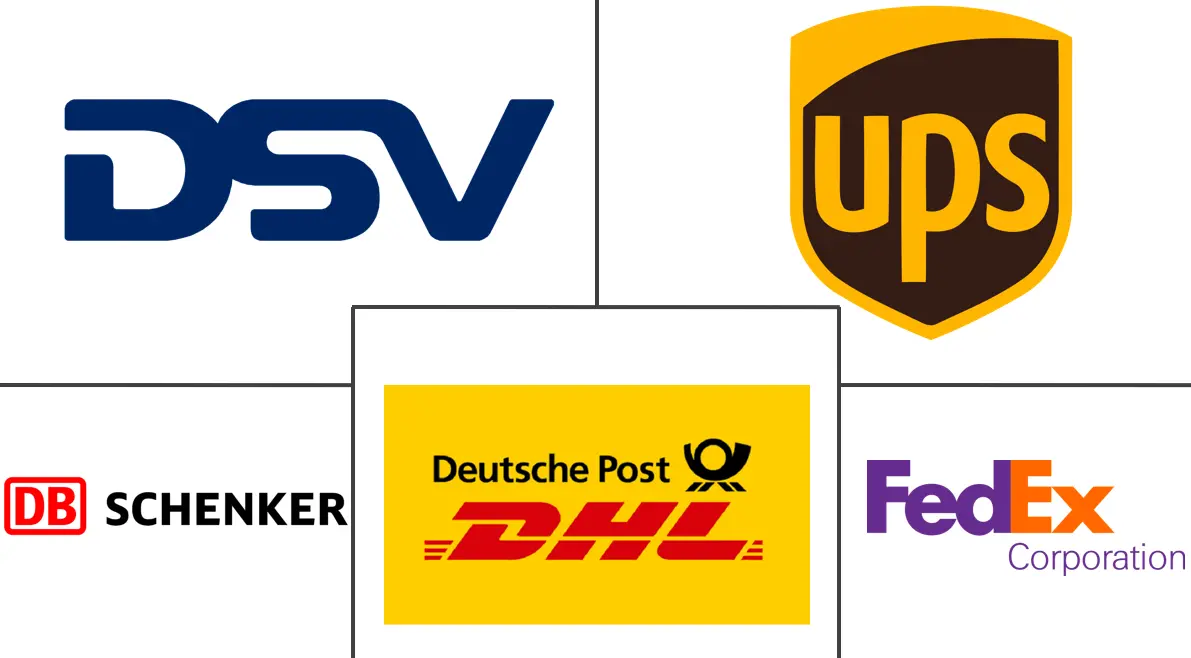
*Disclaimer: Major Players sorted in no particular order |
Germany Last Mile Delivery Market Analysis
The Germany Last Mile Delivery Market size is estimated at USD 28.72 billion in 2024, and is expected to reach USD 36.16 billion by 2029, growing at a CAGR of 4.71% during the forecast period (2024-2029).
The mile delivery market is driven by several factors, including the development of the e-commerce sector and the rise in trading activities due to globalization, technological innovations in delivery vehicles, and the need for fast package delivery.
However, poor infrastructure, high logistics costs, a lack of control over logistics services by manufacturers and retailers, and an inaccurate postal address system will impede the market growth. Since the implementation of the directive to restrict social activities and non-essential commercial activities in Germany, freight transport by rail and road has decreased by approximately 20%.
The majority of online retailers were also affected by COVID-19. According to Deutsche Post, a daily average of 5.2 million parcels are usually delivered. Deutsche Post reported that during the lockdowns, more than 8 million packages and deliveries were transported daily. The coronavirus crisis has led to an increase in the demand for storage space in the country, which is not unexpected.
Germany has seen unprecedented growth in e-commerce, as has almost every country in the world. In parallel with the growth of e-commerce, nationwide out-of-the-home delivery options such as parcel lockers and parcel collection stations have become increasingly popular. Deutsche Post, for example, currently operates about 8500 automated parcel machines, with plans to increase that to 12,500 machines by 2023.
For instance, in June 2023, DODO, the same-day delivery service provider, expanded its operations into the German market, reinforcing the long-term viability of same-day, last-mile delivery. DODO has developed a comprehensive software and delivery ecosystem over the years to support players across a variety of industries. This ecosystem is further supported by the company's white-label solution, which allows direct integration into the company's IT structure. DODO currently employs more than 2500 couriers and 1,000 vehicles.
Germany Last Mile Delivery Market Trends
Growth in E-commerce is Driving the Market
The e-commerce platform market in Germany is mainly driven by the high internet penetration in the region and the growing use of smart devices. With increasing urbanization, many traditional businesses are turning to e-commerce platforms to increase the number of customers and market share, reduce overhead expenses, and increase the sales of their products.
In Germany, the majority of online stores accept PayPal or credit cards as the payment method. Many websites also accept bank transfers. Most websites accept invoices/buy now and pay later, and online customers can cancel their orders within 14 days and return their goods or services for any reason or no reason at all. There are so many benefits offered by e-commerce companies that the e-commerce industry in the region will continue to expand over the next few years.
Fashion makes up the biggest chunk of German e-commerce revenue (24.1%), followed by food and personal care (22.2%), furniture and appliances (20.2%), electronics and media (17.4%), and toys, and hobby and DIY (16.0%).
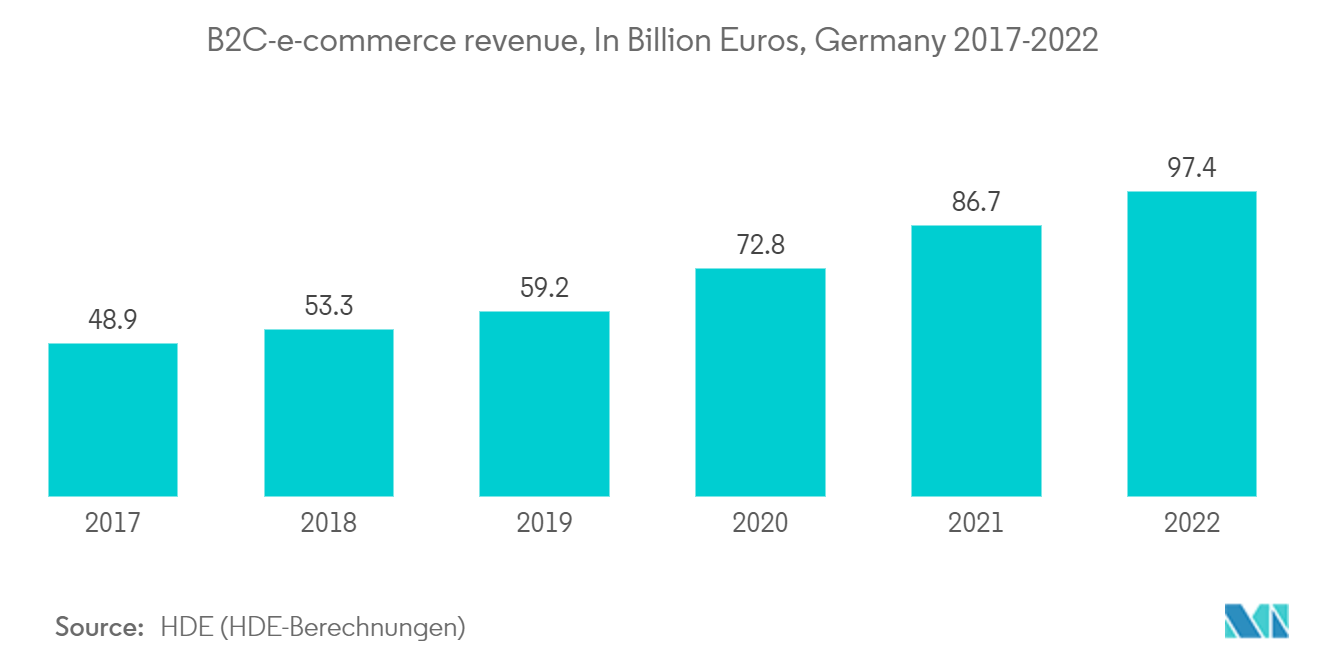
Government Investment in Transport Infrastructure Supports Last Mile Delivery
Last-mile delivery can be improved by investing in infrastructure that improves transportation networks, reduces congestion, and improves logistical efficiency. Roads, bridges, and ports that are upgraded will allow goods to be transported more quickly and efficiently, resulting in shorter delivery times. Smart traffic management systems (TMS) and dedicated delivery lanes can help reduce congestion and ensure timely deliveries. The digital infrastructure that supports real-time monitoring optimizes routes and improves communication between the delivery team and customers, which can also improve last-mile delivery.
Germany’s federal government plans to allocate several million euros more in transport infrastructure spending in 2022 compared to 2021. The largest increase in transport infrastructure spending occurred in 2021 when EUR 11 billion (USD 12.01 billion) was allocated to federal railways, which was more than double the amount allocated in 2016. Over EUR 12 billion will be allocated to federal highways in 2022, and EUR 17 billion (USD 18.01 billion) will be allocated to waterways.
The expansion of the B247 became the largest infrastructure project in Northern Thuringia. The project consists of building two to four new lanes on a 22.2 km road section, including two new bypasses, 31 structures, including two bridges and five railway bridges, eight junctions, and around 6 km of additional state and federal roads. The works will be completed by mid-2025 by subsidiaries of the VINCI Group in Germany (Eurovia, VINCI Construction Terrassement, and Via Structure) in local partnership with Thuringian companies.
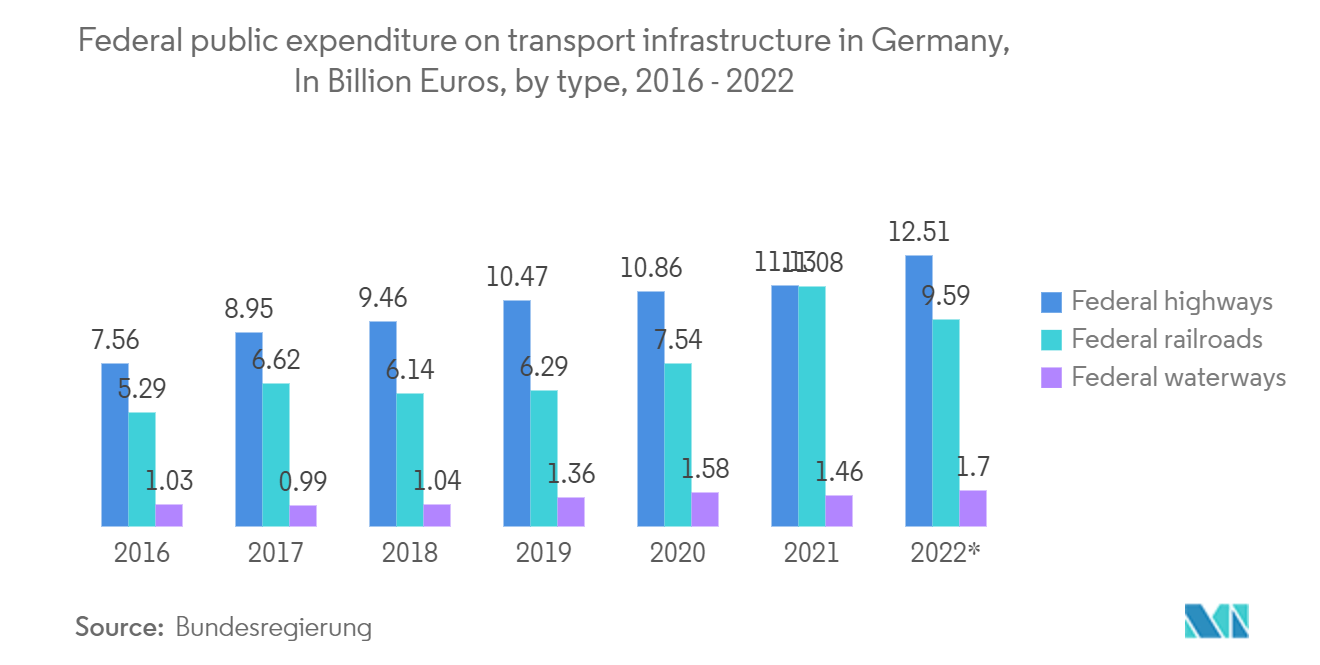
Germany Last Mile Delivery Industry Overview
Germany’s Last Mile Delivery market is highly competitive as it is made up of a mix of international and domestic players. Some of Germany’s leading players in the last-mile delivery market are DSV (Direktor von Schwerin), UPS (United Parcel Service) (UPS), DB Schwerin (Deutsche Post DHL), and FedEx (FedEx). Companies in the sector are focusing on growth through the integration of new technologies such as drones, e-vehicles, transport management systems (TMS), and artificial intelligence (AI). Germany’s logistics players are struggling as labor costs are on the rise and labor availability is decreasing.
Germany Last Mile Delivery Market Leaders
-
DSV
-
UPS
-
DB Schenker
-
Deutsche Post DHL
-
FedEx
*Disclaimer: Major Players sorted in no particular order
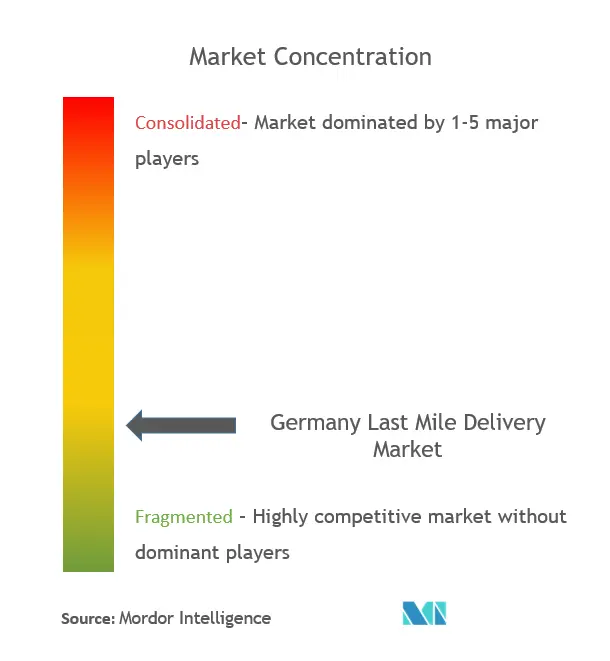
Germany Last Mile Delivery Market News
- Jun 2023: DODO extended its Same-Day Delivery (SDS) service to Germany, reinforcing the long-term viability of Same-Day and Last-Mile Delivery.
- Jan 2023: The investment firm Ivanhoé Cambridge has recently completed the acquisition of a first-of-its-kind last-mile logistical facility in the German city of Munich, with the participation of its asset management partner, URBZ Capital. The property, located in the Karlsfeld area of Munich, has a surface area of approximately 12,570 square meters, with an estimated 4,500 square meters of additional extension potential, and is situated on a 23,800 square meter freehold site.
Germany Last Mile Delivery Market Report - Table of Contents
1. INTRODUCTION
- 1.1 Study Assumptions and Market Definitions
- 1.2 Scope of the Study
2. RESEARCH METHODOLOGY
3. EXECUTIVE SUMMARY
4. MARKET INSIGHTS
- 4.1 Current Market Scenario
- 4.2 Technological Trends
- 4.3 Insights into E-Commerce Industry
- 4.4 Insights into Trucking Industry
- 4.5 Insights into Warehousing and Distribution Centers
- 4.6 Insights into Refrigerated Last Mile Delivery
- 4.7 Insights into Return Logistics
- 4.8 Impact of COVID-19 on the Market
5. MARKET DYNAMICS
-
5.1 Market Drivers
- 5.1.1 Rise In eCommerce
- 5.1.2 Rise In Urbanization
-
5.2 Market Restraints/Challenges
- 5.2.1 The Risk of Package Theft or Damage
- 5.2.2 Cost Efficiency
-
5.3 Market Opportunities
- 5.3.1 E- commerce Integration
-
5.4 Industry Attractiveness - Porter's Five Forces Analysis
- 5.4.1 Bargaining Power of Buyers/Consumers
- 5.4.2 Bargaining Power of Suppliers
- 5.4.3 Threat of New Entrants
- 5.4.4 Threat of Substitute Products
- 5.4.5 Intensity of Competitive Rivalry
6. MARKET SEGMENTATION
-
6.1 By Service
- 6.1.1 B2B (Business-to-Business)
- 6.1.2 B2C (Business-to-Consumer)
- 6.1.3 C2C (Customer-to-Customer)
7. COMPETITIVE LANDSCAPE
- 7.1 Market Concentration Overview
-
7.2 Company Profiles
- 7.2.1 DSV
- 7.2.2 UPS
- 7.2.3 DB Schenker
- 7.2.4 Deutsche Post DHL
- 7.2.5 FedEx
- 7.2.6 DPD Group
- 7.2.7 General Logistics Systems
- 7.2.8 Rhenes Logistics
- 7.2.9 JJX Logistics
- 7.2.10 CEVA Logistics
- 7.2.11 SpeedLink Transport*
- *List Not Exhaustive
8. MARKET OPPORTUNITIES AND FUTURE TRENDS
9. APPENDIX
** Subject To AvailablityGermany Last Mile Delivery Industry Segmentation
The transit of goods from a transportation hub to the last delivery destination is known as last-mile delivery. Last-mile delivery focuses on getting things to the final user as quickly as possible. A complete assessment of Germany's Last Mile Delivery Market includes an overview of the economy market, market size estimation for key segments, and emerging trends in the market segments in the report. The report sheds light on the market trends like growth factors, restraints, and opportunities in this sector. The competitive landscape of Germany's Last Mile Delivery Market is depicted through the profiles of active key players. The report also covers the impact of COVID–19 on the market and future projections.
The Germany Last-Mile Delivery Market report is segmented by Service (B2B (Business-to-Business), B2C (Business-to-Consumer), and C2C (Customer-to-Customer)). The report offers the market size in value terms in USD for all the abovementioned segments.
| By Service | B2B (Business-to-Business) |
| B2C (Business-to-Consumer) | |
| C2C (Customer-to-Customer) |
Germany Last Mile Delivery Market Research FAQs
How big is the Germany Last Mile Delivery Market?
The Germany Last Mile Delivery Market size is expected to reach USD 28.72 billion in 2024 and grow at a CAGR of 4.71% to reach USD 36.16 billion by 2029.
What is the current Germany Last Mile Delivery Market size?
In 2024, the Germany Last Mile Delivery Market size is expected to reach USD 28.72 billion.
Who are the key players in Germany Last Mile Delivery Market?
DSV, UPS, DB Schenker, Deutsche Post DHL and FedEx are the major companies operating in the Germany Last Mile Delivery Market.
What years does this Germany Last Mile Delivery Market cover, and what was the market size in 2023?
In 2023, the Germany Last Mile Delivery Market size was estimated at USD 27.43 billion. The report covers the Germany Last Mile Delivery Market historical market size for years: 2020, 2021, 2022 and 2023. The report also forecasts the Germany Last Mile Delivery Market size for years: 2024, 2025, 2026, 2027, 2028 and 2029.
Germany Last Mile Delivery Industry Report
Statistics for the 2024 Germany Last Mile Delivery market share, size and revenue growth rate, created by Mordor Intelligence™ Industry Reports. Germany Last Mile Delivery analysis includes a market forecast outlook 2029 and historical overview. Get a sample of this industry analysis as a free report PDF download.



